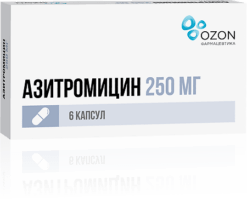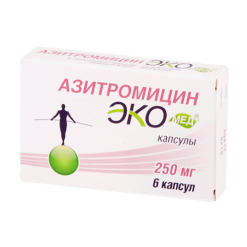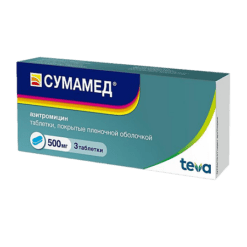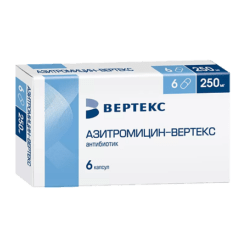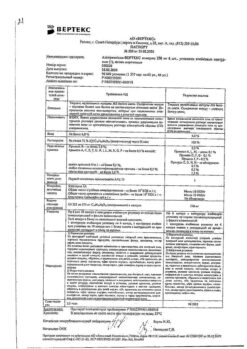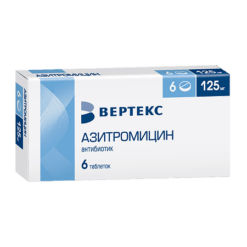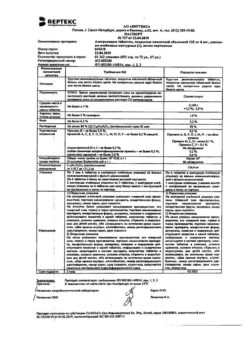No products in the cart.
Azithromycin, 500 mg 3 pcs
€1.00
Out of stock
(E-mail when Stock is available)
Description
Azithromycin is a bacteriostatic broad-spectrum antibiotic of the macrolide-azalid group. It has a wide range of antimicrobial action. Azithromycin mechanism of action is associated with inhibition of microbial cell protein synthesis. Binding to 50S-subunit of ribosomes, it inhibits peptide translocation stage and inhibits protein synthesis, slowing down the growth and reproduction of bacteria. In high concentrations it has a bactericidal effect.
It has activity against a number of Gram-positive, Gram-negative, anaerobic, intracellular and other microorganisms.
Microorganisms can be initially resistant to the action of the antibiotic or can become resistant to it.
The sensitivity scale for microorganisms to azithromycin (Minimum Inhibitory Concentration (MIC), mg/L):
| Microorganisms | MIC, mg/L | Sensitive | |
| Staphylococcus | ≤ 1 | > 2 | |
| Streptococcus A, B, C, G | ≤ 0.25 | > 0.5 | |
| S. pneumoniae | ≤ 0.25 | ||
| H. influenzae | ≤ 0.12 | > 4 | |
| M. catarrhalis | ≤ 0.5 | > 0.5 | |
| N. gonorrhoeae | ≤ 0.25 | ||
.In most cases, susceptible microorganisms
- Grampositive aerobes
Staphylococcus aureus (methicillin-sensitive strains),
em>Streptococcus pneumoniae (penicillin-sensitive strains),
Streptococcus pyogenes.
- Gram-negative aerobes<./li>
Haemophilus influenzae,
Haemophilus parainfluenzae,<
Legionella pneumophila,
Moraxella catarrhalis,
Pasteurella multocida,
Neisseria gonorrhoeae.
- Anaerobes
Clostridium perfringens,
Fusobacterium spp.,
Prevotella spp,
Porphyromonas spp.
- Other microorganisms<
Chlamydia trachomatis,
Chlamydia pneumoniae,<
Chlamydia psittaci,
Mycoplasma pneumoniae,
Mycoplasma hominis,
Borrelia burgdorferi.
Microorganisms that can develop resistance to azithromycin
Streptococcus pneumoniae (penicillin-resistant strains).
Initially resistant microorganisms
Grampositive aerobes
Enterococcus faecalis,
Staphylococcus spp. (methicillin-resistant strains of Staphylococcus aureus show a very high degree of resistance to macrolides),
Gram-positive bacteria that are resistant to erythromycin.
Anaerobes
Bacteroides fragilis.
Pharmacokinetics:
Assimilation
After oral administration, azithromycin is well absorbed and rapidly distributed in the body. After a single dose of 500 mg the bioavailability is 37% (first-pass effect), the maximum concentration (0.4 mg/L) in the blood is created after 2-3 hours.
Distribution
The apparent volume of distribution is 31.1 L/kg, binding to proteins is inversely proportional to the concentration in the blood and is 7-50%. It penetrates through cell membranes (effective in infections caused by intracellular pathogens). It is transported by phagocytes to the site of infection, where it is released in the presence of bacteria. Easily passes the histohematic barriers and enters the tissues. Concentration in tissues and cells is 10-50 times higher than in plasma, and in the focus of infection 24-34% higher than in healthy tissues.
Metabolism
Azithromycin is demethylated in the liver, losing activity.
Elimation
Azithromycin has a very long half-life of 35-50 h. The tissue elimination half-life is much longer. The therapeutic concentration of azithromycin is maintained up to 5-7 days after the last dose. Azithromycin is excreted mainly unchanged – 50% by the intestine, 6% by the kidneys.
Indications
Indications
Infectious and inflammatory diseases caused by microorganisms sensitive to the drug:
Active ingredient
Active ingredient
Composition
Composition
Composition per 1 tablet:
The active ingredient:
Azithromycin dihydrate (in terms of azithromycin) – 524 mg (500 mg)
Auxiliary substances:
Pregelatinized starch – 63.00 mg, hyprolose – 63.00 mg, copovidone – 36.00 mg, crosspovidone – 31.50 mg, calcium hydrophosphate anhydrous – 142.00 mg, talc – 22.50 mg, sodium lauryl sulfate – 7.20 mg, magnesium stearate – 10.80 mg;
Composition of the film coating: hypromellose – 13.60 mg, macrogol 6000 – 2.70 mg, talc – 15.0 mg, titanium dioxide – 3.60 mg, dimethicone – 0.10 mg.
How to take, the dosage
How to take, the dosage
Ingestion, without chewing, 1 time a day, at least 1 hour before or 2 hours after meals.
Infections of the upper and lower respiratory tract, ENT organs, skin and soft tissue – 1 tablet (500 mg) 1 time daily for 3 days (course dose – 1.5 g).
In Lyme disease (initial stage of borreliosis) – erythema migrans. (erythema migrans) – once daily for 5 days: Day 1, 1.0 g (2 tablets of 500 mg), then from day 2 to day 5, 1 tablet (500 mg) daily (cumulative dose of 3.0 g).
Infections of the urogenital tract caused by Chlamydia trachomatis (urethritis, cervicitis) – 1 g once (2 tablets of 500 mg).
In acne vulgaris of moderate severity, 1 tablet (500 mg) once daily for 3 days, then 1 tablet (500 mg) once weekly for 9 weeks (course dose of 6.0 g). The first weekly tablet should be taken 7 days after taking the first daily tablet (day 8 from the start of treatment); the next 8 weekly tablets should be taken 7 days apart.
Special patient groups
In patients with impaired renal function:
In patients with a GFR of 10-80 ml/min, no dose adjustment is necessary.
In patients with impaired liver function:
In patients with mild to moderate impaired liver function, no dose adjustment is required.
Elderly patients:
Dose adjustment is not required. Because the elderly may already have current proarrhythmogenic conditions, caution should be exercised when using the drug because of the high risk of cardiac arrhythmias, including pirouette-type arrhythmias.
Interaction
Interaction
Antacid drugs
The antacid drugs do not affect bioavailability of azithromycin, but decrease the maximum blood plasma concentration of azithromycin by 30%, therefore the drug should be taken at least one hour before or two hours after taking these drugs and meals.
Cetirizine
Concomitant use for 5 days in healthy volunteers of azithromycin with cetirizine (20 mg) did not result in pharmacokinetic interaction or significant change in QT interval.
Didanosine (didezoxynosine)
The concomitant use of azithromycin (1200 mg/day) and didanosine (400 mg/day) in 6 HIV-infected patients showed no change in the pharmacokinetic readings of didanosine compared with the placebo group.
Digoxin and colchicine (P-glycoprotein substrates)
. Concomitant use of macrolide antibiotics, including azithromycin, with P-glycoprotein substrates such as digoxin and colchicine results in increased serum P-glycoprotein substrate concentrations. Thus, when azithromycin and digoxin or colchicine are used concomitantly, the possibility of increased serum concentrations of digoxin or colchicine should be considered.
Zidovudine
The concomitant use of azithromycin (single administration of 1000 mg and multiple administration of 1200 mg or 600 mg) has little effect on pharmacokinetics, including renal excretion of zidovudine or its glucuronide metabolite. However, azithromycin administration caused an increase in the concentration of phosphorylated zidovudine, the clinically active metabolite in peripheral blood mononuclear cells. The clinical significance of this finding is unclear.
Asithromycin interacts weakly with cytochrome P450 isoenzymes. Azithromycin has not been found to be involved in pharmacokinetic interactions similar to erythromycin and other macrolides. Azithromycin is not an inhibitor and inducer of cytochrome P450 isoenzymes.
Alkaloids of ergot
In view of the theoretical possibility of ergotism, concomitant use of azithromycin with ergot derivatives is not recommended.
Pharmacokinetic studies have been performed on the concomitant use of azithromycin and drugs whose metabolism involves cytochrome P450 isoenzymes.
Atorvastatin
Concomitant use of atorvastatin (10 mg daily) and azithromycin (500 mg daily) did not cause changes in plasma concentrations of atorvastatin (based on HMK-CoA reductase inhibition analysis). However, in the post-registration period there were isolated reports of cases of rhabdomyolysis in patients receiving azithromycin and statins simultaneously.
Carbamazepine
Pharmacokinetic studies with healthy volunteers showed no significant effect on plasma concentrations of carbamazepine and its active metabolite in patients receiving azithromycin concomitantly.
Cimetidine
In pharmacokinetic studies of the effect of a single dose of cimetidine on the pharmacokinetics of azithromycin, no changes in the pharmacokinetics of azithromycin were found, provided that cimetidine was used 2 hours before azithromycin.
Indirect-acting anticoagulants (coumarin derivatives)
In pharmacokinetic studies, azithromycin did not affect the anticoagulant effect of a single dose of 15 mg warfarin taken by healthy volunteers. Potentiation of anticoagulant effect has been reported after concomitant use of azithromycin and indirect anticoagulants (coumarin derivatives). Despite the fact that causal relationship has not been established, the need for frequent monitoring of prothrombin time when using azithromycin in patients receiving oral anticoagulants of indirect action (coumarin derivatives) should be considered.
Cyclosporine
. In a pharmacokinetic study involving healthy volunteers who received oral azithromycin (500 mg/day once) for 3 days followed by cyclosporine (10 mg/kg/day once), there was a significant increase in maximum plasma concentration (Cmax) and the area under the concentration-time curve (AUC0-5) of cyclosporine. Caution should be exercised when concomitant use of these drugs. If concomitant use of these drugs is necessary, plasma concentrations of cyclosporine should be monitored and the dose adjusted accordingly.
Efavirenz
The concomitant use of azithromycin (600 mg/day once daily) and efavirenz (400 mg/day) daily for 7 days did not cause any clinically significant pharmacokinetic interaction.
Fluconazole
Concomitant use of azithromycin (1200 mg once daily) did not alter the pharmacokinetics of fluconazole (800 mg once daily). Total exposure and half-life of azithromycin were not altered by concomitant use of fluconazole, but there was a decrease in Cmax of azithromycin (by 18%), which had no clinical significance.
Indinavir
The concomitant use of azithromycin (1200 mg once) had no statistically significant effect on the pharmacokinetics of indinavir (800 mg three times daily for 5 days).
Methylprednisolone
Asithromycin has no significant effect on the pharmacokinetics of methylprednisolone.
Nelfinavir
The simultaneous use of azithromycin (1200 mg) and nelfinavir (750 mg 3 times daily) causes increased equilibrium serum concentrations of azithromycin. No clinically significant adverse effects have been observed and no dose adjustment of azithromycin is required when used concomitantly with nelfinavir.
Rifabutin
The concomitant use of azithromycin and rifabutin has no effect on the serum concentrations of either drug. Neutropenia was sometimes observed when azithromycin and rifabutin were used concomitantly.
While neutropenia has been associated with the use of rifabutin, a causal relationship between the use of a combination of azithromycin and rifabutin and neutropenia has not been established.
Sildenafil
When used in healthy volunteers, there is no evidence of an effect of azithromycin (500 mg/day daily for 3 days) on the AUC and Cmax of sildenafil or its major circulating metabolite.
Terfenadine
In pharmacokinetic studies there has been no evidence of interaction between azithromycin and terfenadine. Single cases have been reported in which the possibility of such an interaction could not be completely ruled out, but there has been no specific evidence that such an interaction has occurred.
The concomitant use of terfenadine and macrolides has been found to cause arrhythmias and prolongation of the QT interval.
Theophylline
No interaction between azithromycin and theophylline has been identified.
Triazolam/midazolam
There are no significant changes in pharmacokinetic parameters when azithromycin is used simultaneously with triazolam or midazolam in therapeutic doses.
Trimethoprim/sulfamethoxazole
The concomitant use of trimethoprim/sulfamethoxazole with azithromycin showed no significant effect on Cmax, total exposure or renal excretion of trimethoprim or sulfamethoxazole. Serum azithromycin concentrations were consistent with those found in other studies.
Special Instructions
Special Instructions
If a dose of the drug is missed, the missed dose should be taken as soon as possible, and the subsequent doses should be taken 24 hours apart.
Asithromycin should be taken at least one hour before or two hours after taking antacids.
The drug should be used with caution in patients with mild to moderate hepatic impairment because of the possibility of fulminant hepatitis and severe hepatic failure.
In cases of hepatic impairment, azithromycin therapy should be discontinued if there are symptoms of hepatic impairment, such as rapidly increasing asthenia, jaundice, darkened urine, increased bleeding tendency, hepatic encephalopathy.
In patients with impaired renal function: In patients with a GFR of 10-80 ml/min, no dose adjustment is required.
As with other antibacterial agents, patients should be regularly evaluated during therapy with azithromycin for the presence of non-susceptible microorganisms and signs of superinfections, including fungal infections.
The drug should not be used for longer courses than indicated, since the pharmacokinetic properties of azithromycin recommend a short and simple dosing regimen.
There are no data on possible interaction between azithromycin and derivatives of ergotamine and dihydroergotamine, but because of the development of ergotism when using macrolides with derivatives of ergotamine and dihydroergotamine simultaneously, this combination is not recommended.
The development of pseudomembranous colitis caused by Clostridium difficile, both as mild diarrhea and severe colitis, is possible with long-term administration of azithromycin. If antibiotic-associated diarrhea develops against the background of the drug, as well as 2 months after the end of therapy, clostridial pseudomembranous colitis should be excluded. Drugs that inhibit intestinal peristalsis are contraindicated.
In treatment with macrolides, including azithromycin, prolongation of cardiac repolarization and QT interval have been observed, increasing the risk of cardiac arrhythmias, including pirouette-type arrhythmias.
Cautions should be taken when using the drug in patients with the presence of proarrhythmogenic factors (especially in elderly patients), including congenital or acquired prolongation of the QT interval; in patients taking antiarrhythmic drugs of classes IA (quinidine, procainamide), III (dofetilide, amiodarone and sotalol), cisapride, terfenadine, antipsychotic drugs (pimozide), antidepressants (citalopram), fluoroquinolones (moxifloxacin and levofloxacin), in patients with electrolyte and water balance disorders, especially in case of hypokalemia or hypomagnesemia, clinically significant bradycardia, cardiac arrhythmia or severe heart failure.
The use of the drug may provoke development of myasthenic syndrome or cause exacerbation of myasthenia gravis.
As well as with erythromycin and other macrolides, rare cases of serious allergic reactions, including angioedema and anaphylaxis (in rare cases with fatal outcome), skin reactions have been reported, including acute generalized exanthematous pustulosis (OGEP), Stevens-Johnson syndrome, toxic epidermal necrolysis (rarely fatal), drug rash with eosinophilia and systemic manifestations (DRESS syndrome). Some of these reactions developing with azithromycin were recurrent and required long-term treatment and monitoring. If an allergic reaction develops, the drug should be discontinued and appropriate treatment initiated. It should be borne in mind that after withdrawal of symptomatic therapy, symptoms of allergic reaction may recur.
When undesirable effects on the nervous system and organs of vision develop, caution should be exercised while performing activities requiring increased concentration and rapid psychomotor reactions.
Contraindications
Contraindications
Myasthenia; mild to moderate hepatic dysfunction; terminal renal failure with glomerular filtration rate less than 10 ml/min; in patients with proarrhythmogenic factors (especially in elderly patients): with congenital or acquired prolongation of the QT interval, in patients receiving therapy with antiarrhythmic drugs of classes IA (quinidine, procainamide), III (dofetilide, amiodarone and sotalol), cisapride, terfenadine, antipsychotic drugs (pimozide), antidepressants (citalopram), fluoroquinolones (moxifloxacin and levofloxacin), with electrolyte balance disorders, especially in case of hypokalemia or hypomagnesemia, with clinically significant bradycardia, cardiac arrhythmia or severe heart failure; concomitant use of digoxin, warfarin, cyclosporine.
Side effects
Side effects
The frequency of side effects listed below was determined according to the following (World Health Organization classification): very common (more than 10%), common (more than 1% and less than 10%), infrequent (more than 0.1% and less than 1%), rare (more than 0.01% and less than 0.1%), very rare (less than 0.01%), including individual reports; frequency is unknown (cannot be estimated using available data).
Infectious diseases: infrequent – candidiasis, including oral mucosa, vaginal infection, pneumonia, fungal infection, bacterial infection, pharyngitis, gastroenteritis, respiratory disease, rhinitis; frequency unknown – pseudomembranous colitis.
Disorders of the blood and lymphatic system: infrequent – leukopenia, neutropenia, eosinophilia; very rare – thrombocytopenia, hemolytic anemia.
Disorders of metabolism and nutrition:infrequent – anorexia.
Nervous system disorders: frequent – headache; infrequent – dizziness, impaired sense of taste, paresthesias, somnolence, insomnia, nervousness; rare – agitation; frequency unknown – hypoesthesia, anxiety, aggression, syncope, seizures, psychomotor hyperactivity, loss of sense of smell, perversion of smell, loss of sense of taste, myasthenia, delirium, hallucinations.
Visual organ disorders: infrequently – visual impairment.
Hearing and labyrinth disorders: infrequent – hearing disorder, vertigo; frequency unknown – hearing disorder, including deafness and/or tinnitus.
Cardiac disorders: infrequent – sensation of palpitations; frequency unknown – prolongation of the QT interval on the electrocardiogram, pirouette-type arrhythmia, ventricular tachycardia.
Vascular disorders: infrequent – “flushes” of blood to the face; frequency unknown – lowering of blood pressure.
Disorders of the respiratory system, thorax and mediastinum:infrequent – shortness of breath, nosebleed.
Disorders of the gastrointestinal tract: very common – diarrhea; common – nausea, vomiting, abdominal pain; infrequent – flatulence, dyspepsia, constipation, gastritis, dysphagia, bloating, dry oral mucosa, belching, oral mucosa ulcers, increased salivary gland secretion; very rare – color change of tongue, pancreatitis.
Hepatic and biliary tract disorders: infrequent – hepatitis; rare – impaired liver function, cholestatic jaundice; frequency unknown – liver failure (in rare cases with lethal outcome, mainly in the background of severe liver impairment), liver necrosis, fulminant hepatitis.
Dermal and subcutaneous tissue disorders: infrequent – skin rash, itching, urticaria, dermatitis, dry skin, sweating; rare – photosensitization reaction, acute generalized exanthematous pustulosis (OGEP); frequency unknown – Stephen-Johnson syndrome, toxic epidermal necrolysis, erythema multiforme, drug rash with eosinophilia and systemic manifestations (DRESS syndrome).
Musculoskeletal disorders: infrequent – osteoarthritis, myalgia, back pain, neck pain; frequency unknown – arthralgia.
Kidney and urinary tract disorders: infrequent – dysuria, renal pain; frequency unknown – interstitial nephritis, acute renal failure.
Gender and mammary gland disorders: infrequent – metrorrhagia, impaired testicular function.
In immune system disorders: infrequent – angioedema, hypersensitivity reaction; frequency unknown – anaphylactic reaction.
General disorders: infrequent – edema, asthenia, malaise, feeling of fatigue, facial edema, chest pain, fever, peripheral edema.
Influence on the results of laboratory and instrumental studies: often – decreased lymphocyte count, increased eosinophil count, increased basophil count, increased monocyte count, increased neutrophil count, decreased plasma bicarbonate concentration; infrequent – increased activity of aspartate aminotransferase, alanine aminotransferase, increased concentration of bilirubin in blood plasma, increased concentration of urea in blood plasma, increased concentration of creatinine in blood plasma, changes in plasma potassium, increased plasma alkaline phosphatase activity, increased plasma chloride concentration, increased blood glucose concentration, increased platelet count, decreased hematocrit, increased plasma bicarbonate concentration, change in plasma sodium concentration.
Overdose
Overdose
Pregnancy use
Pregnancy use
Similarities
Similarities
Additional information
| Shelf life | 3 years. Do not use the drug after the expiration date. |
|---|---|
| Conditions of storage | Store at a temperature not exceeding 25 ° C in the original package (carton pack in the package). Keep out of reach of children! |
| Manufacturer | Berezovsky Pharmaceutical Plant, Russia |
| Medication form | pills |
| Brand | Berezovsky Pharmaceutical Plant |
Other forms…
Related products
Buy Azithromycin, 500 mg 3 pcs with delivery to USA, UK, Europe and over 120 other countries.




